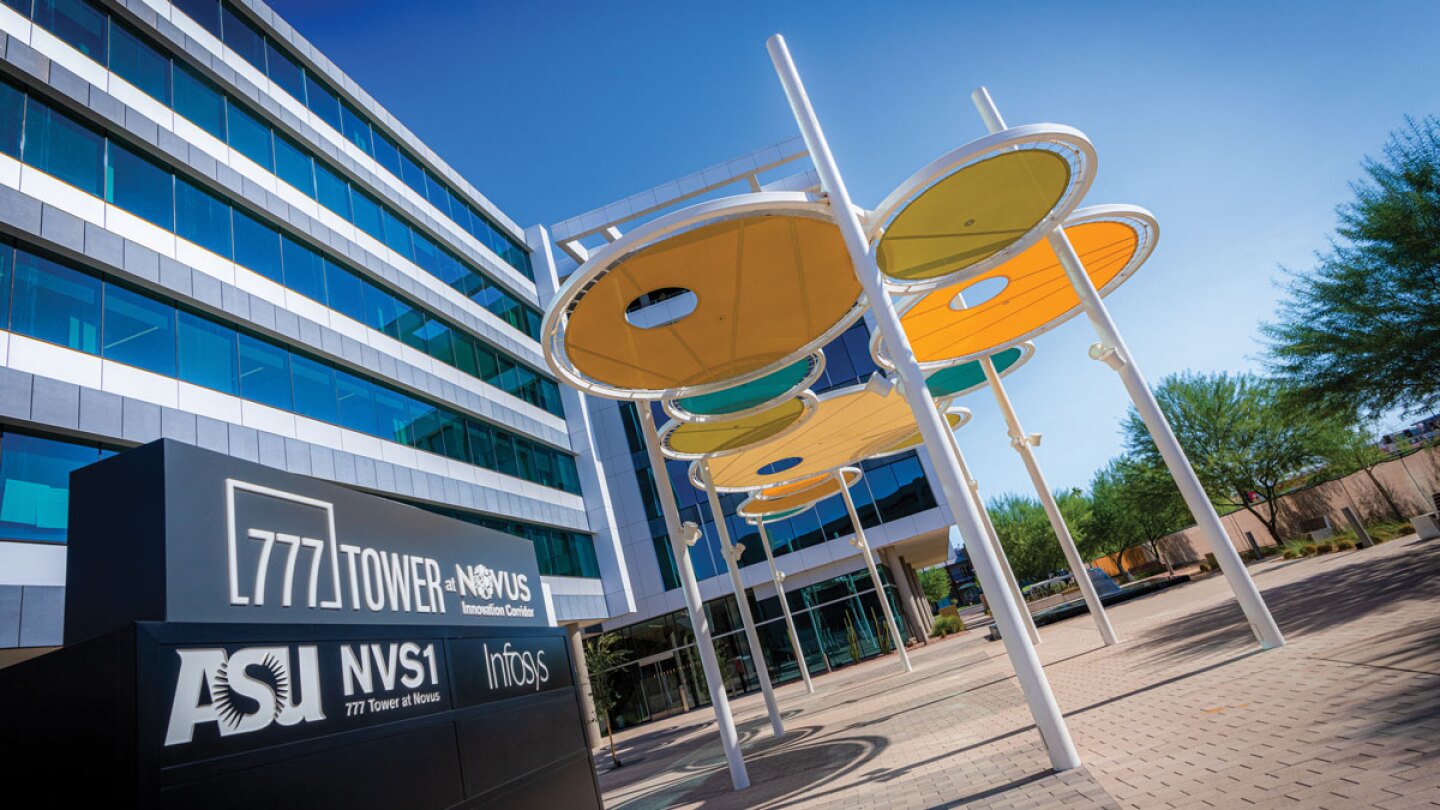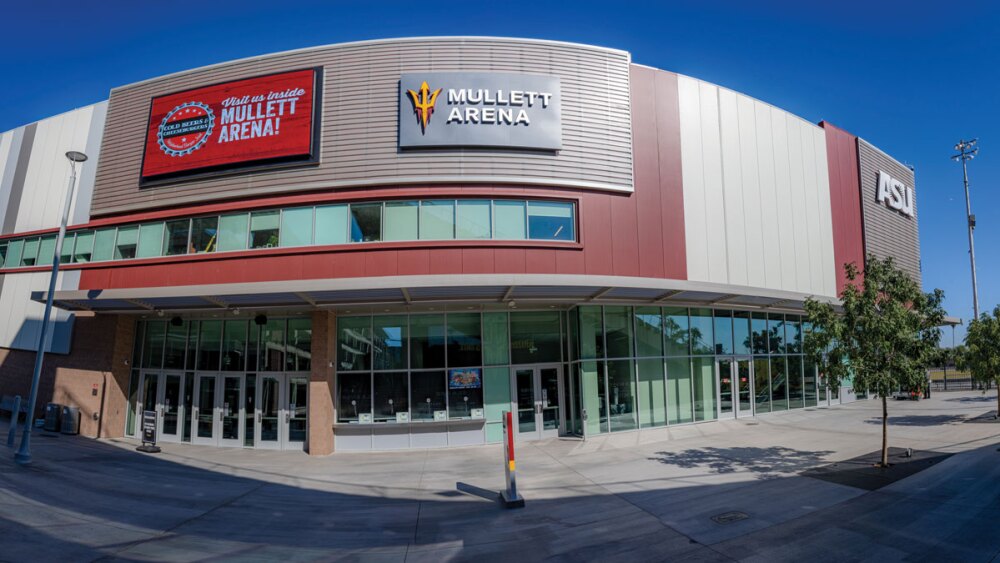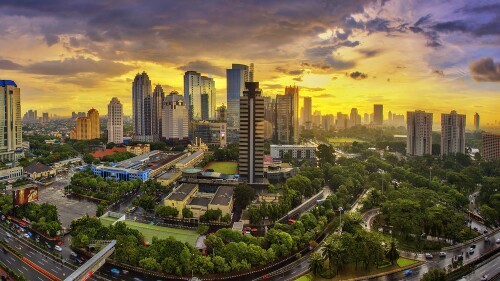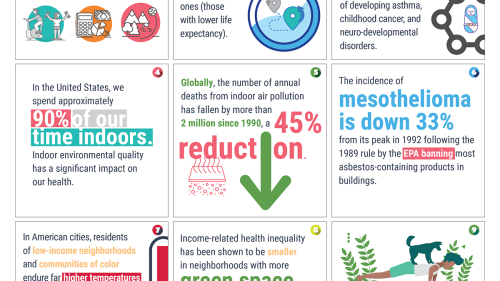Public-private partnership creates a city within a city on 355 acres of undeveloped land located on the 100-year-old ASU campus.
Finding a better urban success story in the last decade than that of the Greater Phoenix metropolitan area would be a real challenge. From 2010 to 2020, the city’s population grew 11.2 percent, with young professionals, middle-class families, and retirees all drawn to the city’s apex of affordability and quality of life. With them, technology companies, regional businesses, and manufacturers moved in, as well—and real estate development has followed.
Today, the Phoenix metropolitan area ranks fourth in the nation for real estate development activity, surpassing such major hubs as Chicago and Los Angeles, as well as other top growth markets, including Atlanta and Miami. In the last decade, the area has undergone the construction of more than 200,000 single-family homes, 95,000 multifamily units, nearly 100,000 square feet (9,290 sq m) of industrial space, and more than 21 million square feet (2 million sq m) of new office space. Yet it is a project from Arizona State University (ASU) that best illustrates the future of the market here.
The Novus Innovation Corridor is a 10 million-square-foot (900,000 sq m) mixed-use development, currently underway in Tempe, Arizona, a suburb of Phoenix, from a public/private partnership between ASU and Catellus Development Corporation. A city within a city, the Novus Innovation Corridor is set on 355 acres (144 hectares) of undeveloped land adjacent to Downtown Tempe and located on the 100-year-old ASU campus.
As part of an innovation zone—one of seven operated by the university—businesses will have access to the knowledge and professional support that they need to grow and scale. Once complete, the live-work-play destination is to feature 4,100 market-rate multifamily units, 1,000 hotel rooms, 6.5 million square feet (604,000 sq m) of commercial office, and 275,000 square feet (25,000 sq m) of retail space, along with public outdoor spaces. All at once, it is a space for the growing set of residents and professionals who will call the area home, and it’s a cash-flowing asset for the school to achieve its outsized goals.
Tapping into new revenue sources
Novus is Latin for new, but in many ways the Novus Innovation Corridor was the rebirth of an existing asset. ASU had 355 acres (144 hectares) of substantially undeveloped land, much of which had been used as a golf course. As the Greater Phoenix metropolitan area has expanded, so, too, has interest in—and attention paid to—the university, which is one of the fastest-growing research institutions in the nation, with record annual enrollment and a growing athletics platform. Unfortunately, state funding has fallen short of keeping pace with the school’s growth, particularly of its athletics programs, and this massive land site was an ideal—and innovative—financial solution.
“We wanted to be sure that we were optimizing the use of an underutilized asset,” says Morgan Olsen, executive vice president, treasurer, and chief financial officer at Arizona State University. “That is increasingly important, and we wanted to provide a revenue stream that would allow us to invest in the renewal and renovation of our athletics facilities.”
ASU is taking advantage of a law passed in 2010 by the Arizona State Legislature that allows universities to establish tax-exempt athletic facilities districts. In lieu of a property tax, private businesses will pay a fee to ASU. The revenue generated will be used to fund the development, upgrades, and maintenance of the school’s athletics facilities.
“To have a world-class university, you have to have world-class athletics, and our district will help to fund the cost of those activities over time,” says Charley Freericks, senior vice president of Catellus Development Corporation, the master developer of the Novus Innovation Corridor. Freericks calls the strategy unique. “When the buildings get built and taxed, there [will be] enough cash flow on the property tax equivalents to debt service the bonds [used] to pay for the athletic facilities.”

Novus features 6.5 million square feet of Class A high-rise, mid-rise and creative office space, including the six-story 777 Tower. The development’s commercial core is poised to drive a significant influx of employment in cutting-edge industries, bringing lifelong learning, commercial, real estate, living, entertainment and research together in one location.
Novus Innovation Corridor
Creating a community
Although the Novus Innovation Corridor provides a financial solution to the school, the vision of the project is much more than a means to an end. ASU has a role to support the success of the community that it serves, according to Olsen. As he explains, the project was an opportunity to address the needs of the surrounding community and the growth in Phoenix, alongside what ASU calls its knowledge assets—that is, its people, talent, and research.
“We are wanting to attract tens of thousands of people and jobs to the Novus Innovation Corridor,” he says. “We want to weave everything together, so it makes sense as an integrated whole. We are creating a place where people want to be, both because of the experience but also for access to the university’s knowledge.”
ASU wanted to bring a spectrum of commercial uses to the project and to create a space that truly transformed the downtown area. For Catellus, there was no better site in the southwestern U.S. to build such a community-centered destination. In addition to its sheer size, the property is located at the intersection of Phoenix, Tempe, and Scottsdale, along a major roadway, and near the city’s international airport. “I think it is the best piece of property in the [Southwest],” says Freericks. “It is an unusually rare opportunity to complete an urban infill redevelopment on bare land.”
The property has been carefully designed to align with the school’s master plan and integrate seamlessly into the existing fabric of the neighborhood and the campus. The project has a 25-year timeline, with multiple phases. Starting in 2014, phase one delivered a 2.1 million-square-foot (195,000 sq m) build-to-suit office space for State Farm. In phase two, the development team completed a $300 million redevelopment of Sun Devil Stadium.
Catellus is now undertaking phase three, which will include hotels, office buildings, multifamily communities, street-level retail, and a public park. “We are trying to be disciplined and provide a good mix of uses. It makes for better living for the people … in those phases,” says Freericks. “It is complementary to the existing community fabric.”
The third phase is to include a handful of standouts, including the Hyatt Place/Hyatt House dual-branded hotel, which has a rooftop pool and fitness center; Mullett Arena, home to the National Hockey League’s Arizona Coyotes, as well as to ASU men’s and women’s hockey; and offices for several major companies, including Infosys, a global digital services and consulting firm, which has a space in 777 Tower, a mid-rise office building. The project is expected to create 33,734 jobs and generate $2 billion in annual wages and $4.6 billion in annual economic impact.
Although the project is community-serving, it is also embedded in the educational weave of the university. Albeit set in the middle of Downtown Tempe, it is also surrounded on three sides by ASU functions—one reason that Olsen believes the project has been so well received. “The Novus Innovation Corridor has been so successful because of its proximity to the university and the talent that we produce,” he says. “That is a value to organizations in a variety of ways. It provides human capital and a labor force, but it is also a good quality of life. All of those things have come together to create this opportunity set.”
Of course, the university will also benefit from having such a vibrant environment at its doorstep, and that has helped to inform and guide some of the decisions. “At some point, we realized that we were also helping to create the neighborhood for the Tempe campus for the next 50 to 100 years,” says Olsen. “We will definitely be eating our own cookie, so to speak.”
Public/private partnership achieves the vision
Of course, developing a raw 355-acre (144 hectares) site is no easy feat—particularly for an educational institution. ASU pursued a public/private partnership (PPP) to accomplish its vision and goals. Going through the standard request-for-proposal (RFP) process, Olsen says they received several attractive proposals but found a good match in Catellus Development Corporation. “We were looking for a partner that would be with us over the long haul, for the whole ride,” says Olsen, adding that the developer has assisted in every step of the horizontal development, including sourcing tenants for retail and hospitality.
For its part, Catellus is an expert in public/private partnerships. It has worked with cities and public institutions to develop and redevelop spaces into mixed-use properties, and it understands the nuances of the joint venture. “The PPP structure is not for everyone,” admits Freericks. “It is complicated.”
With the right partnership, it is also tremendously beneficial, he added. ASU is an educational institution, and its board of regents wants the school to remain focused on education rather than on these types of growth initiatives. In a public/private partnership, a developer brings the experience and resources to do the project, and the institution gets to maintain some control. “You end up with great decision-making,” says Freericks. “It allows [the university] to accomplish their goals without detracting from their mission, and we get to do what we do best.”
A long-term partnership also helps mitigate exposure to economic downcycles, and it’s proving helpful now as office demand has receded somewhat, following the pandemic. “We know there will be cycles, and we are anticipating that as we implement our plan,” says Olsen, adding that the retail, hospitality, and multifamily components are meeting or exceeding expectations.

ASU Athletics gives local residents a state-of-the-art venue for sports competitions and other events with its multi-purpose Mullett Arena. The arena plays host to the NHL’s Arizona Coyotes, collegiate hockey, wrestling, and women’s gymnastics, along with public concerts, youth competitions, and other events.
Novus Innovation Corridor
The development team is not concerned about the slump in office demand. First, the quality of the office space will help hedge against remote work trends. “We have a lot of things that are pretty positive from a quality standpoint, and we think that will position us as well as anyone,” says Olsen.
In addition, this is a long-term project that is intended to survive market cycles. “We are not concerned about the near-term office issues. We want to make sure that we have the flexibility to continue developing multiple uses during all market cycles,” says Freericks. “We have a long-term perspective, and you can’t overreact to short-term market cycles.”
The Novus Innovation Corridor is an emblem of growth in Phoenix, and a model for the ways that public institutions can create their own economic engines while providing spaces that support the city and the surrounding community. Phoenix is not alone. Throughout the Sun Belt several small cities have experienced a similar wave of population growth and new demand. As those cities look for ways to evolve as they grow, the Novus Innovation Corridor will be an example to replicate.







